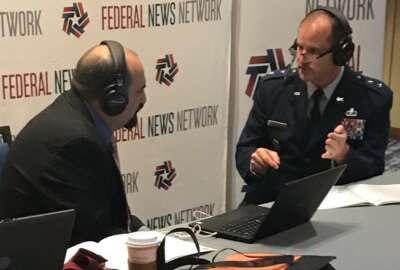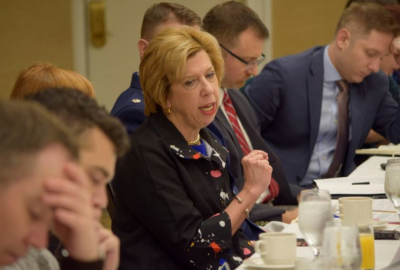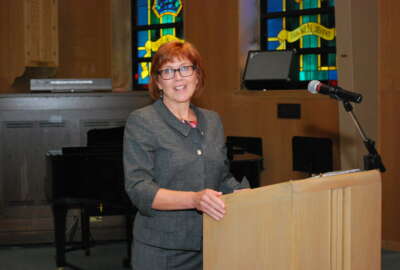
Hubbard Radio Washington DC, LLC. All rights reserved. This website is not intended for users located within the European Economic Area.
Hubbard Radio Washington DC, LLC. All rights reserved. This website is not intended for users located within the European Economic Area.
Defense acquisition leaders are focused on change to the federal procurement system to relieve some of the reasons why many believe it is intransigent and infle...
Air Force Maj. Gen. Cameron Holt knows a little something about the complexity of federal contracting.
The deputy assistant secretary for contracting, in the Office of the Assistant Secretary of the Air Force for Acquisition, Technology and Logistics, started his career as a contracts manager. He served as the procuring contracting officer for the F-22 fighter and held an assortment of executive positions during his 19-year career in the service.
So when he gave the House and Senate armed services committees a list of regulations that need to be revoked, removed or replaced a few years ago, he knows what he’s talking about.

“I told them that you’ve written so many laws that we need to implement that our contracting officers in the trenches can’t even follow them all because they actually start to conflict with each other,” Holt said at the annual Government Contract Management Symposium sponsored by the National Contract Management Association. “That environment is not really paying attention to the opportunities that, for instance, the 809 panel gave to them to update the system. I think they are really focused on a different agenda right now. I hope they will join us in really streamlining, especially the defense contracting environment, but really the federal contracting environment.”
And the most recent version of the National Defense Authorization Act adds dozens of new provisions, including a new requirement for the Defense Department to develop a “strategic framework for prioritizing and integrating sustainment of major defense acquisition programs in support of the national defense strategy, the development of materiel readiness metrics and objectives for major weapon systems and a report on these metrics with each annual budget request.”
Holt and other Defense Department acquisition experts, however, are not waiting for Congress or even their own regulations to catch up with the times.
“On the other side of the coin, I see a renaissance going on. I see people tired of being told ‘no.’ People being tired of all the red tape, a real weariness of overly prescriptive items, and a vastly long time frame and risk averse approaches to contracting,” he said. “In large part led by NCMA and others, I see people really opening the aperture, pushing authorities down and trying new things, and providing blast shield support because the D.C. recrimination culture continues. The difference is we have a lot of courageous leaders in key positions who have had enough of that and are willing to let their folks try new things, make decisions on their own and move a lot faster.”
Holt said Congress gave the Air Force, and DoD more broadly, some of those new authorities through Other Transaction Authority, Commercial Service Offerings and a rapid acquisition approach through the mid-tier acquisition provisions.
But now, he is worried, that Congress and others are taking a step backward by adding more oversight and compliance requirements.
“We have to stop worrying about who signs your performance report and drive unity of effort rather than just unity of command. Our organization structures were born out of the industrial revolution and we haven’t really thought innovatively about it until recently,” Holt said. “We are now making a lot of progress in breaking down some of the barriers of communication and starting to drive unity of effort across functions and across organizations.”
Holt pointed to the Air Force’s focus on digital acquisition, calling it a renaissance where the service is embracing open systems architecture, digital engineering and agile software development.
“Underlying all of that is digital contracting. As we develop that digital thread in using really high speed tools for a digital and technical environment for the prime and all subcontractors to operate within, we are asking new questions in contracting like why do we write proposals to begin with? Why can’t we just attach the cost and overheads inside that digital environment so that there is ultimate transparency and you can turn on or off people’s views of what they can see to protect cost and proprietary information?” he said. “At the same time instead of the standard process we go through where we write a proposal that takes months and months to come in and that proposal has very little to do with actually what’s going on, and in some cases it’s way high. We could leverage data and technology to get to the point where the actual negotiation is just a discussion about risk and then we hit print or not hit print on the proposal and move forward.”
Will Roper, the assistant secretary of the Air Force for Acquisition, Technology and Logistics, said at the NCMA event that the service is “using MacGyver-like techniques to make the system do things it wasn’t originally envisioned” to do.
“We have to explain, both upwards to leadership above us as well as to the field why we are encouraging this behavior,” he said. “The period in which the FAR was created is very different than today. The government was still the central driver of the technology in this nation. We represented most of the research and development in the nation during the height of the Cold War. I don’t think the original drafters of the FAR would’ve imagined a complete 180. So we must hack the system to be relevant.”
One way the Air Force is hacking the system is by rethinking current regulations. For instance, funding for operations and maintenance of systems.
Roper said he’s writing a new memo with the general counsel and financial management offices to bring more flexibility into one-year O&M funding-known as 3400 money.
“I don’t think the original envision of different colors of money was not to allow us to do common sense things. It’s to operate and sustain. I think the implication is operate and sustain relevant things. If you are creating a completely new bomber instead of sustaining your old one, you’ve crossed the line and you know that,” he said. “If you are making reasonable improvements to your system to keep it relevant for the original purpose to which it was built, that is what that account is for and we have given that up. It’s a great example of the kind of conservatism that has now overwrought our system into being intransigent and inflexible.”
Rebecca Weirick, the Army’s deputy assistant secretary for procurement, said changing the way agencies are funded to eliminate single-year funding is one of biggest changes that is needed.

“Our program managers are rated not only how well they spend money, but how well they disperse it. That is not the right motivation,” she said. “This is something we have been pounding on for years to no end, but we are hopeful.”
These “hacks” are not just happening in the Air Force. The Army released a new strategy for the contracting enterprise that is focused on training its contracting officers and program managers.
Weirick said one of the big improvements is using virtual reality to speed up the education process of contracting officers to become experts.
“Is there a way, like we do flight simulation, which is at least as complex as contracting, to simulate the entire process with some artificial intelligence and imagine all different outcomes to give them experience,” she said. “It’s very early in that discussion. But we see that as a great future.”
She said automation particularly around things like compliance requirements and pricing determinations also will play a big role in the future.
Weirick said the Army also is asking for exceptions to the Competition in Contracting Act (CICA) and to the AbilityOne program.
She said the CICA exception would be a pilot through category management where the Army would demonstrate savings when buying commercial items.
The AbilityOne competition exception would let the Army buy certain items from other sources that they deem less expensive, but continue to support companies that hire workers who are disabled.
“We’ve asked for and have received that and are piloting two in the Army. I’m leading a subcommittee to expand that across the federal government. We are really excited about that too,” Weirick said.
What the Army and Air Force, and for that matter several other agencies, are demonstrating is the acquisition system doesn’t have to be , as Roper called it, intransigent and inflexible. It just takes leaders who are willing to get out in front on a consistent and constant basis and promote real and perceived innovation to change the culture.
Copyright © 2024 Federal News Network. All rights reserved. This website is not intended for users located within the European Economic Area.
Jason Miller is executive editor of Federal News Network and directs news coverage on the people, policy and programs of the federal government.
Follow @jmillerWFED


